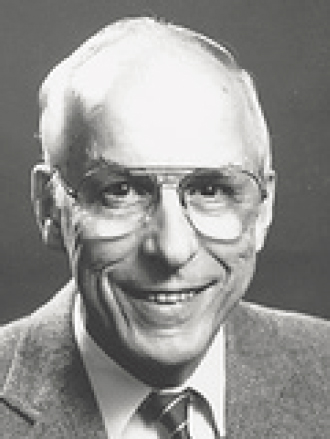
DALE L. CRITCHLOW
1932–2016
Elected in 1991
“For technical leadership and key contributions to the development of metal-oxide semiconductor (MOS) devices and dynamic random access memory (DRAM) technology.”
BY JOHN M. COHN
DALE L. CRITCHLOW was one of the world’s leading experts in the science and business of semiconductor memory. The innovations that he and his team drove have made possible everything from cell phones to supercomputers.
Dale died May 6, 2016, of cancer in Shelburne, Vermont, at age 84. He was born January 6, 1932, in Harrisville, Pennsylvania, the son of Lee and Susie Critchlow. He was a graduate of Grove City College (1953) and received his master’s (1954) and doctoral (1956) degrees in electrical engineering from Carnegie Institute of Technology (now Carnegie Mellon University). He then spent 2 years as an assistant professor at Carnegie Tech before joining IBM Research in Yorktown Heights, New York, in 1958. In 1977 he moved to IBM East Fishkill, NY, and in 1981 to Essex Junction, VT, where he finished his 35-year IBM career.
At IBM Dale became one of the world’s leading experts in metal oxide–semiconductor field-effect transistors (MOSFETs) and their application to dynamic random access memory (DRAM). In 1973 he and his colleagues Robert Dennard (NAE) and Stanley Schuster published the seminal paper that outlined the physics and mathematics of semiconductor scaling:
“Design and Characteristics of n-Channel Insulated-gate Field-Effect Transistors.”1
Dale’s longtime collaborator and one-time employee Bob Dennard relates that Dale set the combined technical and business goal of his group to build the world’s first computer memory that cost less than one milli-cent ($0.00001) per bit. That single-minded focus simultaneously drove innovations in semiconductor process scaling (now known as “Dennard scaling”), process technology innovation, and circuit innovations necessary to make the world’s first truly affordable DRAM. The availability of affordable and reliable DRAM has been a key component in the development of all computers from cell phones to supercomputers and has been a direct driver of the $3 trillion growth of the semiconductor industry over the last 4 decades.
In recognition of this body of work, Dale was named a fellow of the Institute of Electrical and Electronics Engineers in 1985 “for contributions to the research and development of LSI [large-scale integration] and VLSI [very large-scale integration] MOSFET technologies.” In 1986 he was named an IBM fellow, the company’s highest technical honor. In 1989 he became a founding member of the IBM Academy of Technology, the company’s technical leadership body.
In 1991 he was deeply honored to be inducted into the National Academy of Engineering—and so inspired by his NAE membership that in 1995 he helped create the Vermont Academy of Science and Engineering (VASE). VASE supports understanding and appreciation of science and technology in Vermont, and under Dale’s guidance established grant programs that support hands-on science in Vermont schools.
In 1993 Dale retired from corporate life and returned to teaching, a wonderful way to share his decades of experience with the next generation, whether they were young employees or students. He was an outstanding and demanding teacher, and for 13 years a much-admired adjunct professor at the University of Vermont.
___________________
1 IBM Journal of Research and Development 17(5):430.
He was a man of many interests and active in both mind and body. He was an avid cyclist and enjoyed pedaling Vermont’s green mountains into his 80s. He was also a gifted woodworker and helped establish a state-of-the-art woodworking facility at the Wake Robin retirement community where he and his wife Alice lived. The beautiful and elegant desks and tables he made can be found everywhere around Wake Robin.
Dale leaves behind his beloved wife of 60 years, Alice Ellenberger Critchlow, and large and loving family: their daughter Sally Terris and her husband, Bruce; daughter Kathryn Luther and her husband, Mark; son John Critchlow and his wife, Jennifer; five grandchildren, and eight great-grandchildren. Dale was able to hold his first great-grandchild just the week before he died.
Dale was a strong and inspiring technical leader. His attention to scientific rigor, his deep understanding of human nature, and his dry, folksy humor made him an inspiring technical and personal mentor to many people at IBM, across the industry, at the University of Vermont, and in the communities where he and his family lived. All of us are very grateful to have known Dale Critchlow.




